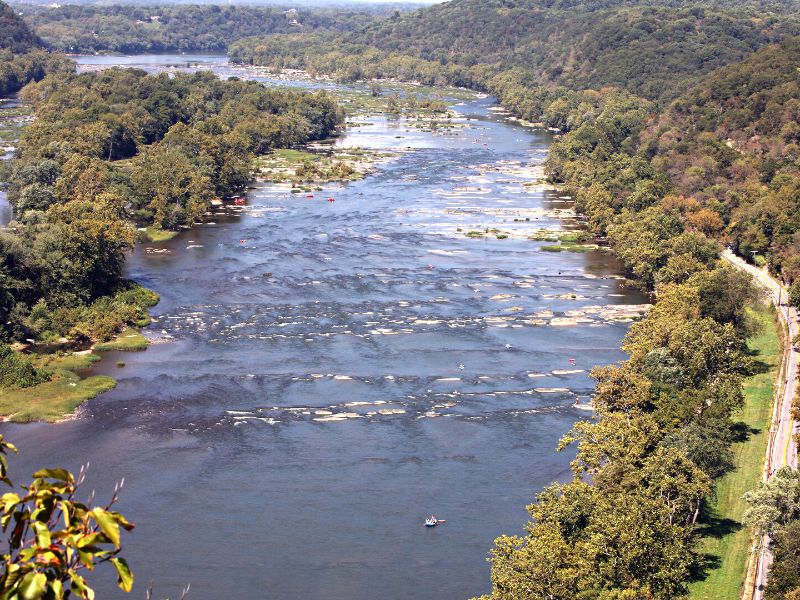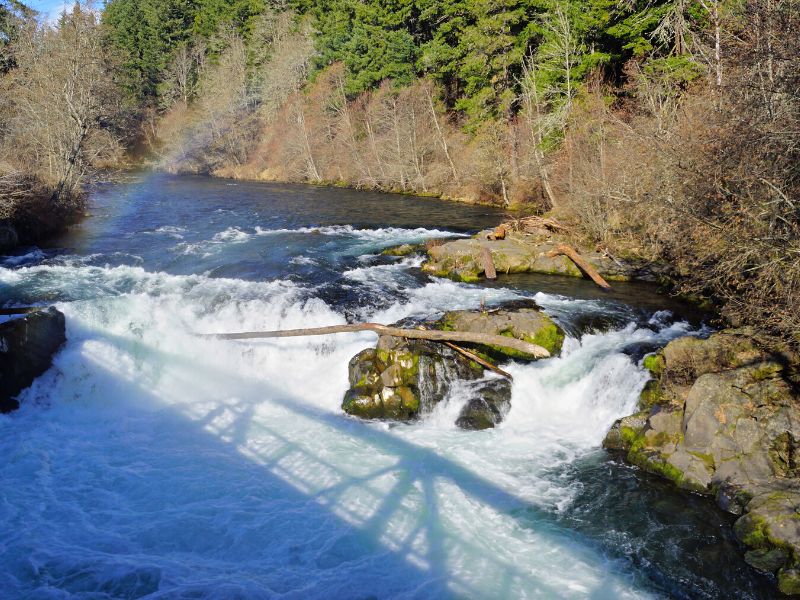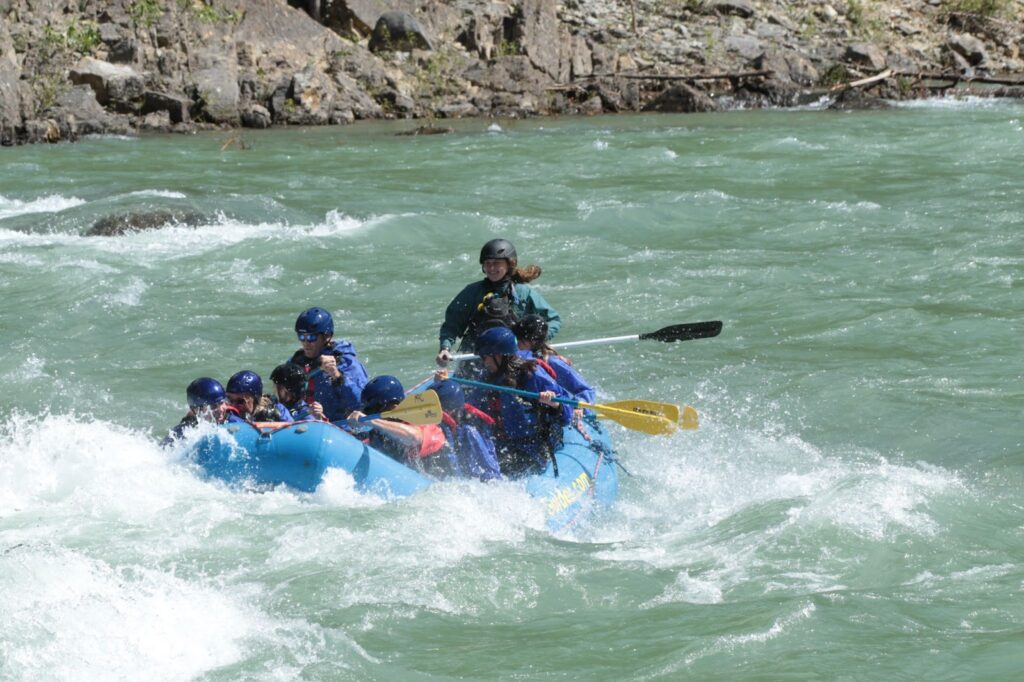Whitewater rapids can be a thrilling experience for those looking for an adventure. Rapids are classified based on level, between Class I to VI. Class I and II are easy to moderate waters with some waves but are still suitable for beginners. Class III is great for intermediate levels. Class IV and V provide a challenge with powerful rapids needing precise maneuvering and technical skills. Class VI is the most extreme, and paddlers are facing the possibility of death or severe injury. Consider yourself an Olympian if you’re doing Class VI rapids. Note that the sites below will have a range of difficulty levels.

The Arkansas River, Buena Vista, Colorado
The Colorado River is a mighty waterway. For beginner trails, go to the Upper Colorado River for some class II rapids near Brown’s Canyon National Monument. While you are in Colorado, check out other rivers and lakes for more adventure. Where to launch:
Where to launch:
- Buena Vista Whitewater Park 715 E Main St, Buena Vista, CO 81211
Elk River, Harrison, Arkansas
The Elk River in Harrison, Arkansas, is home to Class I and II rapids. The river’s winding path offers beautiful scenery and a relaxing rafting experience—the river gorges through the Elk-Buffalo National River, home to over 600 free-range Elk. Check out the Buffalo River Elk Festival, which is celebrated each summer in June.
Where to launch:
- Elk River Public Access 116 Rhine St, Pineville, MO 64856
James River – Richmond, VA
The Upper James River is a section of the James River located in Richmond, Virginia. It has a wide channel making it an excellent choice for those just starting on whitewater rapids. The Upper James River also offers some of the best views in Virginia and insight into the nation’s early history and culture, with many sites dotting the area. Check out a complete description of the river on America Whitewater’s website.
Where to launch:
- Ancarrow’s Landing 1200 Brander St, Richmond, VA 23224
Ocoee River – Benton, TN
The Ocoee River in Benton, TN, is a popular beginner whitewater destination in the US. This specific section is known for its spectacular gorge and diverse wildlife. Being 93 miles long, it is easily accessible from Atlanta, Chattanooga, and Knoxville. Ocoee Outdoors is a great local outfitter with a great guide and tips for first-time rafters.
Where to launch:
- Ocoee Outdoors 1985 US-64, Benton, TN 37307
Potomac River – Great Falls, MD
The Potomac River is a mid-Atlantic waterway that flows out of the Potomac Highlands and into the Chesapeake Bay. Four hundred five miles long, it is one of the largest rivers on the east coast. The Potomac River in Great Falls, Maryland, is a beginner-friendly section with Class I and II rapids. The river’s wide channel and scenic views make it an excellent choice for those who are just starting on whitewater rapids.
Where to launch:
- Algonkian Regional Park Boat Ramp 47001 Fairway Dr, Sterling, VA 20165

Shenandoah River – Luray, VA
The Shenandoah River in Luray, VA, is an ideal section for beginners. It is a principal tributary of the Potomac River. The river is excellent for canoeing, kayaking, tubing, and camping activities.
Where to launch:
- Bealers Ferry Boat Launch State Rte 684, Luray, VA 22835
Nantahala River – Bryson City, NC
The Nantahala River in Bryson City, North Carolina, is one of the US’s most popular beginner whitewater destinations as the water current is moderate and the waves are consistent. The rapids are Class I and II, making them a great choice for first-timers. The Nantahala River is also home to some of the best views in North Carolina. It is known as a “family” river with gentle Class II and III rapids, making it suitable for families with children.
Where to launch:
- Nantahala River Launch Site – Wayah Rd, Topton, NC 28781
New River – Fayetteville, WV
The New River has a section between Hinton and Thurmond suitable for beginners and intermediate experience levels as it offers class I-III rapids with long pools and moderate rapids. Further downstream are technical rapids class III-IV, and even further downriver is for the most experienced paddlers. The National Park Service website details all the information you need for planning your trip.
Where to launch:
- Lower New River Gorge take-out New River Gorge Bridge, Fayetteville, WV 25840
Gauley River – Summersville, WV
The Lower Gauley River in Summersville, West Virginia, is a scenic section of the river and provides beginner-level rapids. Upper Gauley River is home to up-to-class V. The Gauley River is perfect for all rafting levels. Upstream at the end of the recreation area is Summersville Dam, which provides the water for several towns.
Where to launch
- Salmon Run Boat Ramp Salmon Run Boat Ramp, Summerville Lake, Summersville, WV 26651
Colorado River – Glenwood Springs, CO
The Colorado River in Glenwood Springs, Colorado, is one of the US’s most popular beginner whitewater destinations. The rapids are Class I and II, making them an excellent choice for those with little or no experience. For rafting with kids under five years old, check out Whitewater Rafting, LLC, as they have great mild experiences for families wanting to experience a safe whitewater experience.
Where to launch:
- Whitewater Rafting, LLC 2000 Devereux Rd, Glenwood Springs, CO 81601
Recommended Kayaking Tours for Whitewater Adventures for Beginners
Glenwood Canyon Half-Day Raft Trip in Colorado– This tour of Glenwood Canyon takes you through Class III rapids, but with the guidance of a professional crew, you’re safe from any scares.
The Arkansas River is a favorite for competitive paddlers. For those that aren’t competing but want to have a challenge check out this tour, the Arkansas River Half Day Rafting Tour.
Need to Know for Whitewater Adventures for Beginners
These are just a few beginner-friendly whitewater adventures you can find in the US. So if you’re looking for a way to add excitement to your life, look no further than whitewater rafting!
When it comes to paddling whitewater rapids, there are a few things that beginner rafters should know. First of all, always wear a life jacket. It’s also important to know your limits and never attempt a rapid beyond your skill level. And finally, always be aware of your surroundings and be prepared for anything. With these tips in mind, you will surely have a safe and enjoyable experience paddling whitewater rapids.
Weather Considerations
The most common season for paddling whitewater rapids is summer when the weather is warm, and the water is flowing strong. However, some beginner-friendly whitewater destinations can be enjoyed year-round. If you paddle in the spring, you may have more water coming off the mountains from the melting ice and snow.
You’ll want to wear clothes that can get wet. Most rafters recommend a swimsuit and T-shirt, but you can also wear shorts and a tank top. Whatever you choose to wear, make sure it’s comfortable and won’t restrict your movement. Lastly, don’t forget to bring a towel and sunscreen!

